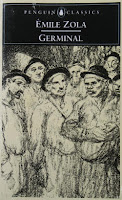 I selected Émile Zola’s Germinal for Book Club in June. I originally read the novel about 10 years ago and reread it for Book Club. By rereading it I’ve come to appreciate Zola’s work even more.
I selected Émile Zola’s Germinal for Book Club in June. I originally read the novel about 10 years ago and reread it for Book Club. By rereading it I’ve come to appreciate Zola’s work even more.When I first read Germinal, I came away with the idea that Zola wanted to address issues of economic classes, labor and society, and basic needs of working class people, such as health care and living wages. Sandwiched into these societal issues were more personal challenges such as love, loyalty, honesty, industry and the literary workings of a tragic character. Zola uses irony and he juxtaposes bourgeois families with poverty-stricken families.
The second time I read Germinal I still appreciated the tragic, uphill struggles of the miners and the individual characters that played a part in this epic story. But what was new to me was the feeling that Zola didn’t so much write a novel as he created a series of paintings that beg us to visualize his settings. We enter the museum (okay, I am visualizing now) and in the first room we see a beautiful but haunting painting of the early-spring landscape (April, or the germinal month), treeless with ugly slagheaps, smoke that curls into the grey sky, and grey figures that are but shadows trudging their way to the mine. It is a beautifully-wrought but haunting landscape.
The next painting perhaps shows old Bonnemort and his horse down in the pit. Over and over Zola portrays the mine as a living monster that devours the workers. We see the haphazard timbering, the hay, the wet walls, and the lamps that provide the only light. There is a sadness to Bonnemort’s face and we detect a bond between the man and the horse. The horse and the man are both slaves within the working mine. They bond because they suffer together.
Another painting shows several miners at work. Their shirts are off and their bodies are glistening with sweat. The air outside is cold, but in this living hell, temperatures rise dramatically. Their arms and shoulders which have worked in the mines for all their lives should be strong and steady. Instead, they seem weak and exhausted.
Still walking through the museum, we see an oil painting that depicts the Maheu’s family room. It’s early morning and Catherine is fixing coffee and building up the fire. Again, it is dark and the oil lamps and the fireplace provide the only lighting. She is careworn but young, a sad figure. Yet, there is somehow hope in her eyes. Hope that she can do better than her parents. Hope that she can find a way to create a comfortable living situation for herself. Hope that she can rise above the rabble.
The labor/union meeting in the woods is carefully composed. This painting is not quite a landscape, but larger than the intimate paintings we have seen of the miners. We see the group, with Étienne, Maheu, Rasseneur all prominently positioned with others eagerly looking on. The peasant dress, the lively discussions, and the fallen branches used as makeshift sitting places all help portray the intensity of the meeting.
I can imagine many more paintings. The pub, the company town of Montsou, and the mob scenes (there are several—Zola seems to excel at describing incredibly realistic and frightening mob scenes) all are adaptable to a visual representation.
I heartily recommend this novel.
And how relevant is a 19th century novel about working in a coal mine, dealing with fair pay and disasters where loved ones are trapped, maimed, or sick from breathing coal dust their whole lives? Surprisingly relevant.
March, 19, 2007: Siberian mine blast kills most in 10 years
“Labor union officials blamed the explosion in part on quota systems that encourage miners to work faster and dig more coal, potentially leading to errors. Some government officials in the past have accused private companies of cutting corners on safety measures in order to save money.” (Source)May 24, 2007: 38 killed in blast at Russian coal mine
And of course, a bit closer to home:
August 6, 2007: 6 trapped in Utah coal mine collapse
Lastly, Germinal is one novel in a 20-volume series depicting several families in 19th century France. Zola’s output is staggering, considering the depth of his characters, descriptions, and actions portrayed in his work.
No comments:
Post a Comment